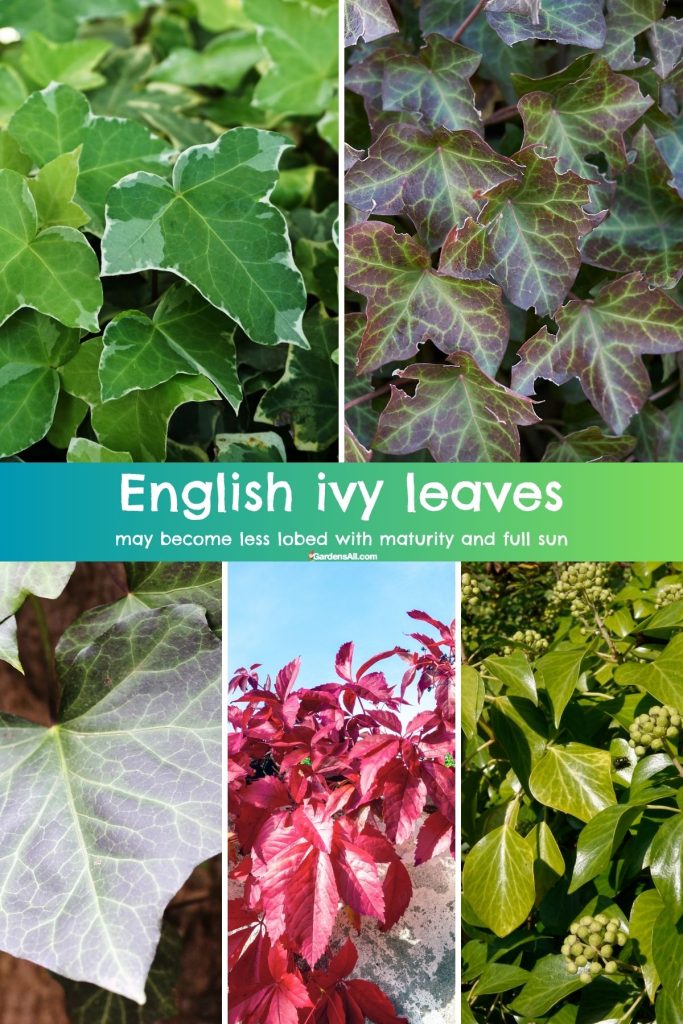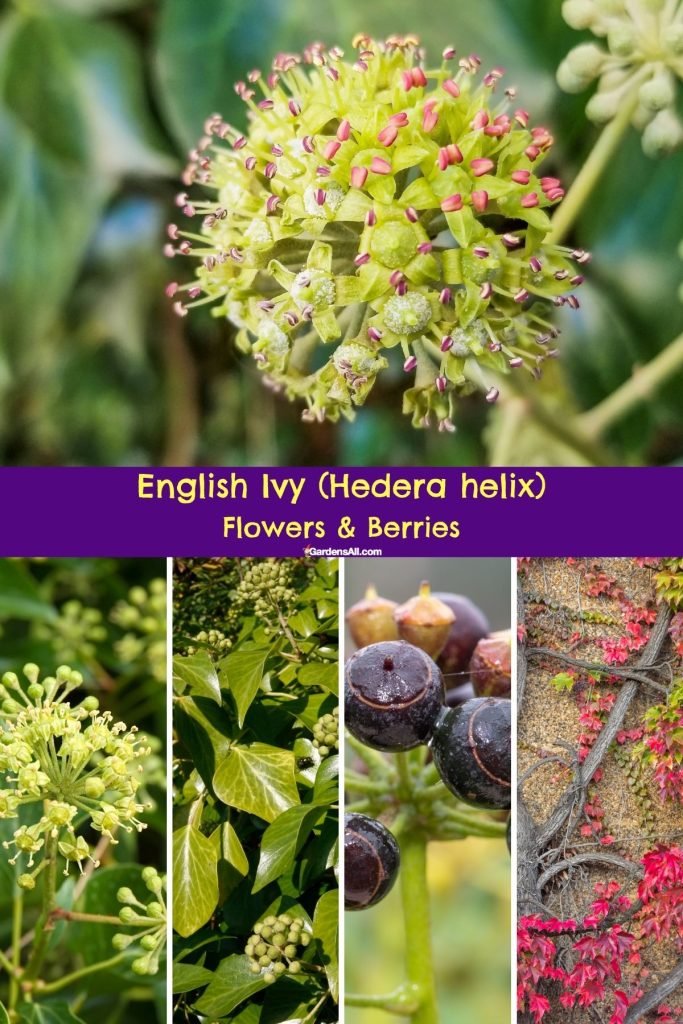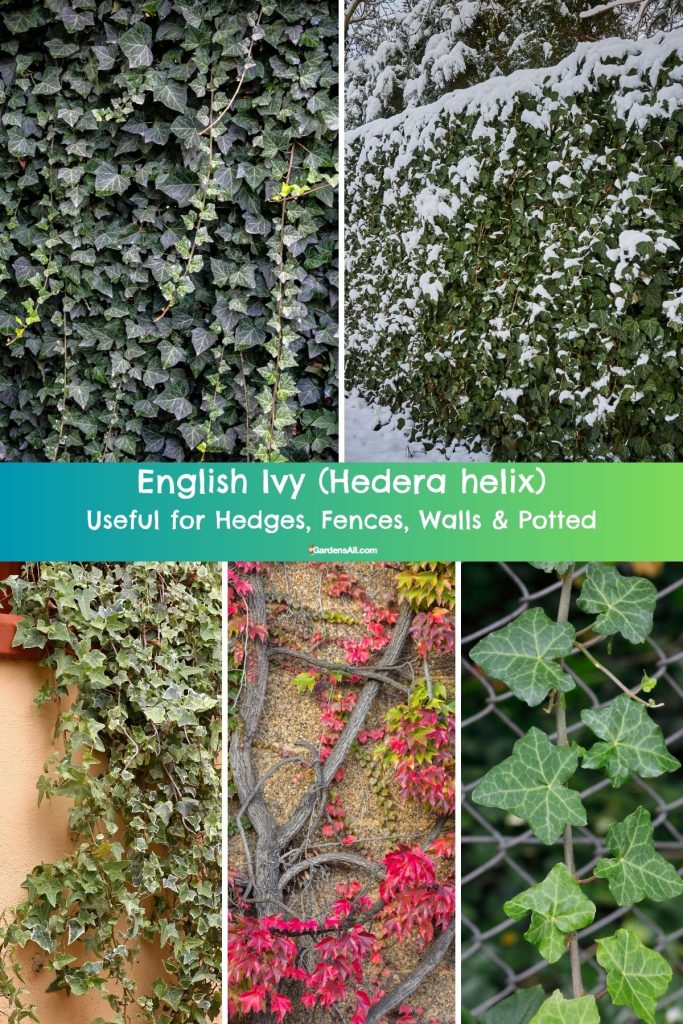The benefits of English Ivy (Hedera helix), extend far beyond its ornamental value. This resilient evergreen vine is known for its air purifying qualities, erosion control capabilities, and its use in traditional medicine, among other advantages.
Understanding the benefits of English Ivy can help homeowners and gardeners appreciate this plant’s contributions. Whether you’re growing—or considering growing—English ivy indoors or outside, this article will help you consider how best to put this unique plant to good use.
English Ivy Description
English Ivy, scientifically known as Hedera helix, is a perennial, evergreen vine native to Europe, western Asia, and northern Africa. It is well-known for its lush, dense foliage and its ability to climb and cover surfaces, making it a popular choice for both indoor and outdoor gardening. Here is a more detailed description of its characteristics:

Physical Characteristics of English Ivy
English Ivy Leaves
English Ivy has dark green, glossy leaves with a leathery texture. The leaves are lobed (typically three to five lobes) when the plant is young and growing in shaded areas. In its mature phase, especially when exposed to full sun, the leaves can become unlobed and may have a slightly different shape.

English Ivy Flowers and Berries
The plant produces small, inconspicuous yellow-green flowers in the fall, which are followed by blue-black berries. These berries are attractive to birds but toxic to humans and pets.

Growth Habit of English Ivy
English Ivy is a versatile climber, using small, root-like structures called aerial rootlets to adhere to surfaces. It can climb up walls, trees, and other vertical structures, reaching heights of 20-30 meters (about 65-100 feet) or more. When not climbing, it spreads across the ground, forming a dense carpet that can suppress weeds.

English Ivy Origin
Native to Europe and parts of Asia, English ivy has been widely adopted across the globe, thriving in a variety of climates and conditions. This adaptability has made it a popular choice for gardens and indoor environments alike.
English Ivy Scientific Name and Family
This taxonomic classification places English Ivy within the Araliaceae family, which includes other well-known plants like the ginseng, is as follows:
- Kingdom: Plantae
- Clade: Angiosperms
- Clade: Eudicots
- Order: Apiales
- Family: Araliaceae
- Genus: Hedera
- Species: Hedera helix
- Genus: Hedera
- Family: Araliaceae
- Order: Apiales
- Clade: Eudicots
- Clade: Angiosperms
Meaning of Hedera helix
The genus name Hedera, while directly referring to ivy in Classical Latin, has connections to ancient linguistic roots that convey the action of seizing, grasping, or taking.
The Proto-Indo-European root *gʰed- and the Greek word χανδάνω (khandánō) etymology reflects the climbing nature of ivy plants, which “grasp” onto surfaces as they grow.
English Ivy Environmental Benefits
Air Purification
The NASA Clean Air Study has shown that English Ivy can significantly improve indoor air. Apparently its dense foliage along with the soil can absorb and reduce airborne pollutants, such as benzene, formaldehyde, and trichloroethylene.[1]https://ntrs.nasa.gov/api/citations/19930073077/downloads/19930073077.pdf
Erosion Control
English Ivy’s vigorous growth and strong root system can help stabilize soil, preventing erosion. It is particularly useful on slopes or areas prone to erosion, where its roots bind the soil, reducing runoff and protecting the soil from being washed away.
Urban Cooling
We live in the woods, and as such, our temperatures are invariably several degrees cooler than in town, something plants and trees are known to do.
So dense foliage plants like English ivy can have a cooling effect not only as a ground cover, but also on fences, as hedges and on buildings. English Ivy can can reduce ground and surface temperatures, which can be beneficial in mitigating the effects of urban heat islands.
Landscape Benefits of English Ivy
English Ivy adds a classic beauty to architectural structures and landscapes. Its dense foliage can beautifully cloak walls and fences, creating a verdant backdrop that enhances the visual appeal of buildings and gardens.
The Hedera helix versatility allows it to thrive in various settings, from full sun to shaded areas, making it a flexible choice for landscaping projects.
Erosion Control Prevention
As mentioned above under environmental benefits, the dense root system of English Ivy is excellent for preventing soil erosion. By anchoring the soil, it minimizes runoff and helps maintain landscape integrity, especially in areas prone to heavy rainfall or on slopes. Its growth can also suppress weed development, offering a natural solution to unwanted plants.
However, if the invasive nature of English ivy is a concern, you may look at less invasive groundcover such as these ground cover plants with flowers.
Wildlife Habitat
English Ivy can provide essential habitat and food for wildlife. Birds often use the thick foliage for nesting, and the berries offer a food source in winter. However, careful management is necessary to ensure it doesn’t outcompete native species.

Medicinal Benefits of English Ivy
Traditionally, English Ivy has been used to treat various health conditions. Its expectorant properties make it useful in treating respiratory issues, while its saponins have antimicrobial and antifungal effects. These uses highlight the plant’s importance in natural medicine.
For a lot more on the medicinal and health benefits of English ivy here.
Managing the Invasive Nature of English Ivy
While English Ivy offers numerous benefits, it’s important to address its invasive nature in outdoor landscapes.
You can control the spread of this vigorous vine by monitoring and controlling its spread through physical removal. The vines can be cut to prevent them from climbing and potentially killing trees. However, the most effective for long term remediation of English ivy invasion is to pull them up by the roots and burn those plants.[2]https://kingcounty.gov/en/legacy/services/environment/animals-and-plants/noxious-weeds/weed-identification/english-ivy
I’m LeAura Alderson, a garden, herb and plant enthusiast with a passion for discovering the many edible and medicinal benefits of the plants all around us, including the weeds! I’m a writer, editor and media publisher for our family of websites.
While I was certified in fitness and life coaching, I am NOT a health practitioner. However, I’m a lifelong health enthusiast, with a keen interest in healthy, organic foods and making home remedies and the content we share is from our own experience and usage as well as that extracted from scientific research so that you can explore further on your own.
Always seek the advice and guidance of your health practitioners first and foremost.
As a family we’re steadily expanding our gardening, experimentation and knowledge around all things gardening, edible landscaping, fresh organic foods and self sustainability with farming in our future. I also own and manage iCreateDaily.com, a site all about transformation through creation, and the power of positivity, optimism and mindset.
References

